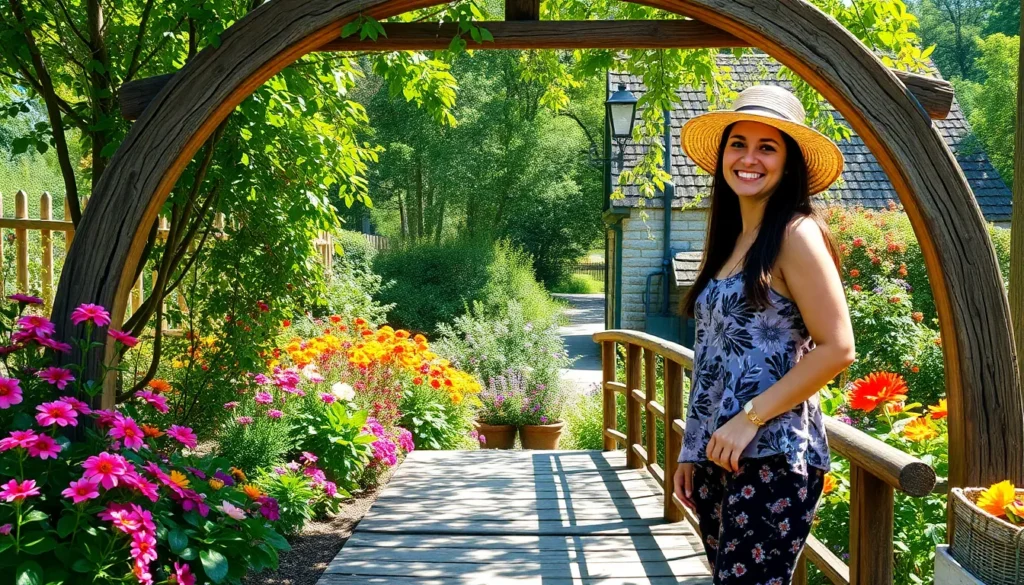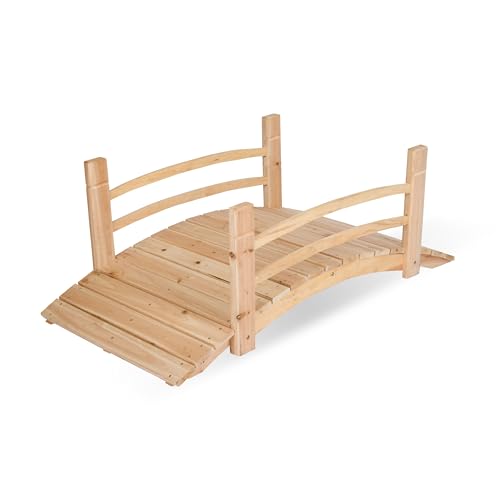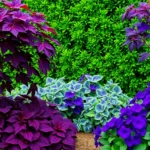We’ve all dreamed of adding that perfect finishing touch to our outdoor space that transforms an ordinary garden into something truly magical. Garden bridges aren’t just functional pathways – they’re stunning focal points that create depth visual interest and undeniable charm in any industry design.
Whether you’re looking to span a small creek connect different garden areas or simply add architectural appeal to your yard the right bridge can become your garden’s crown jewel. From rustic wooden arches that blend seamlessly with natural surroundings to elegant stone structures that make bold statements we’ve discovered countless creative possibilities that’ll inspire your next outdoor project.
The best part? You don’t need a massive budget or professional landscaping experience to install a beautiful garden bridge. With the right design ideas and planning you can create a stunning feature that’ll have neighbors stopping to admire your outdoor masterpiece for years to come.
Classic Wooden Garden Bridge Ideas for Timeless Appeal
Wooden garden bridges bring natural warmth and enduring charm to outdoor spaces. These versatile structures complement various industry styles while providing practical answers for crossing water features or connecting different garden areas.
Traditional Arched Wooden Bridges
Arched wooden bridges create an elegant focal point that draws the eye naturally through your garden space. We recommend cedar or redwood construction for their natural resistance to moisture and insects, ensuring your bridge remains beautiful for decades. The gentle curve of these bridges adds visual interest while allowing easy passage over streams, ponds, or dry creek beds.
Classic arched designs typically feature handrails at 36 inches high with vertical balusters spaced 4 to 6 inches apart for safety and visual appeal. Construction costs range from $200 to $800 depending on size and wood quality. Popular widths include 3 feet for foot traffic and 4 to 5 feet for wheelchair accessibility.
Rustic Log Bridge Designs
Log bridges offer an authentic woodland aesthetic that blends seamlessly with natural garden settings. We suggest using pressure treated logs or naturally rot resistant species like cedar, locust, or oak for maximum longevity. These bridges work exceptionally well in cottage gardens, woodland landscapes, and rustic themed outdoor spaces.
Simple log construction involves placing 6 to 8 inch diameter logs parallel to create the walking surface, secured with galvanized bolts or timber screws. Adding split log handrails maintains the rustic appearance while providing necessary support. Installation typically requires 2 to 3 days and costs between $150 to $500 for materials.
Painted Wood Bridge Options
Painted wooden bridges allow creative expression while protecting the underlying timber from weather exposure. We recommend using exterior grade primer and paint specifically formulated for outdoor wood surfaces to prevent peeling and fading. Popular color choices include classic white for traditional gardens, deep green for natural settings, and bold colors like red or blue for contemporary landscapes.
Preparation involves sanding smooth surfaces, applying quality primer, and using two coats of exterior paint for optimal coverage and protection. Maintenance requires repainting every 3 to 5 years depending on climate conditions and paint quality. Color coordination with existing garden structures creates a cohesive design that enhances your overall industry theme.
Modern Metal Garden Bridge Designs for Contemporary Landscapes
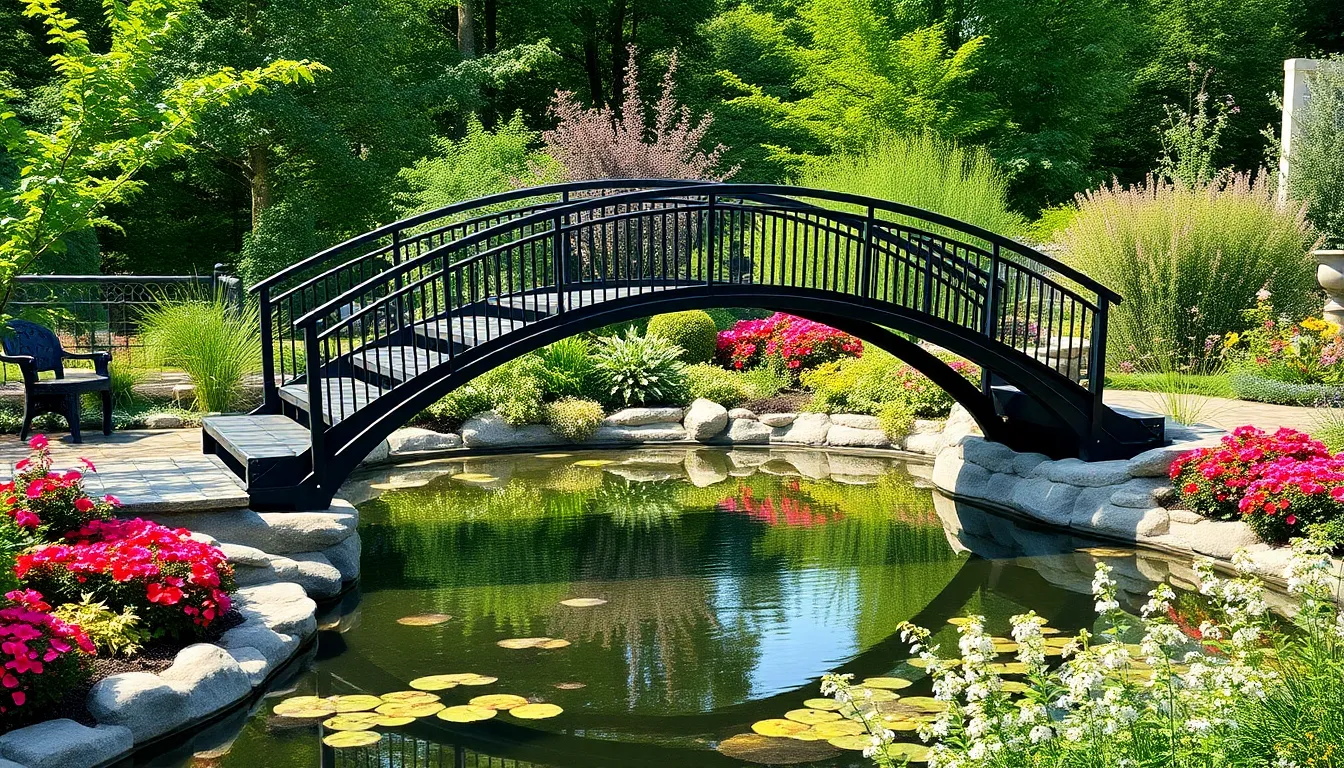
Metal garden bridges deliver a sophisticated alternative to traditional wooden structures while offering exceptional durability for today’s industry designs.
Sleek Steel Bridge Structures
Sleek steel bridges transform outdoor spaces with their clean architectural lines and contemporary appeal. Black powder coated steel emerges as the preferred material choice, providing weather resistance while maintaining that striking modern aesthetic we’re seeing in cutting edge garden designs.
Spanning streams and ponds becomes effortless with these streamlined structures that integrate seamlessly into various garden styles. We can position steel bridges to create dramatic focal points that complement both minimalist zen gardens and elaborate traditional landscapes.
Construction costs typically range from $300 to $1,200 depending on length and design complexity, making steel bridges a worthwhile investment for homeowners seeking long lasting garden features.
Decorative Iron Bridge Ideas
Decorative iron bridges add timeless elegance through intricate metalwork patterns and ornate detailing that captures attention from every garden angle. These structures excel at creating visually appealing pathways across flower beds, small water features, and garden transitions.
Wrought iron designs offer unlimited customization with scrollwork, botanical motifs, and geometric patterns that reflect personal style preferences. We recommend choosing designs that echo existing architectural elements like fence patterns or gate details for cohesive industry integration.
Installation flexibility makes iron bridges versatile for connecting different garden levels or creating stunning walkways over decorative gravel beds and planted areas.
Aluminum Bridge Answers
Aluminum bridges provide lightweight durability without compromising structural integrity, making them ideal for gardens where weight restrictions matter. These practical answers require minimal maintenance while withstanding harsh weather conditions year after year.
Minimal profiles ensure surrounding landscapes shine as aluminum bridges won’t overshadow delicate plantings or water features. We can select from various finishes including natural aluminum, bronze tones, and powder coated colors to match existing garden hardware.
Quick installation saves time and labor costs since aluminum’s lightweight properties make these bridges easier to position and secure compared to heavier metal alternatives.
Stone Garden Bridge Ideas for Natural Integration
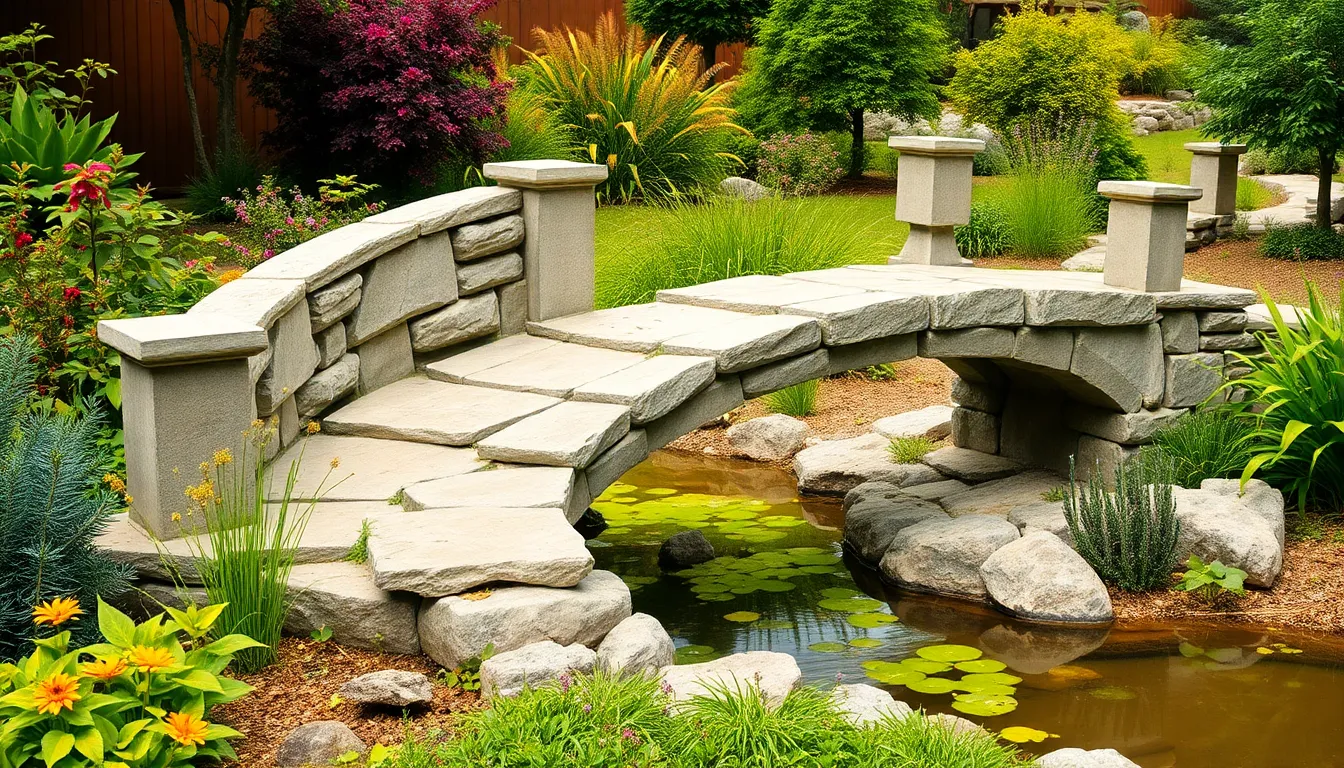
Stone bridges create an authentic connection between garden spaces while establishing a permanent, weather-resistant pathway. These designs complement existing industry features and add substantial value to outdoor environments.
Natural Stone Slab Bridges
Natural stone slab bridges use large, flat stones to create elegant pathways over small water features or garden gaps. These structures blend seamlessly into the industry while providing a completely natural appearance that complements existing rock formations and plant arrangements.
Flagstone slabs work exceptionally well for wider spans, offering stability and visual appeal across streams or decorative ponds. Limestone provides excellent traction even when wet, making it ideal for areas with frequent moisture exposure. Sandstone creates warm, earthy tones that harmonize beautifully with desert or Mediterranean garden themes.
Installation requires careful attention to stone selection and foundation preparation. We recommend choosing slabs at least 3 inches thick for structural integrity. Proper leveling ensures safe passage while maintaining the organic appearance that makes these bridges so appealing.
Stacked Stone Bridge Designs
Stacked stone bridges offer rustic, textured appearances that create dramatic focal points in traditional garden settings. These structures can feature arched designs or straight configurations depending on your desired aesthetic and available space.
Arched stacked stone bridges provide classic appeal reminiscent of European countryside estates. Straight line designs work better for modern industry themes while still maintaining natural stone authenticity. Fieldstone creates the most organic appearance, while cut stone blocks offer more precise geometric patterns.
Construction involves carefully selecting stones of varying sizes to create stable interlocking patterns. Mortar joints should remain minimal to preserve the natural stacked appearance. We suggest incorporating native stones from your local area to ensure perfect color coordination with surrounding industry elements.
Concrete Stone-Look Alternatives
Concrete with stone finishes provides cost-effective answers that deliver realistic natural stone appearances without expensive material costs. These alternatives offer enhanced durability and quicker installation timelines compared to authentic stone construction.
Pre-cast concrete stones are cast in specialized molds that mimic natural stone textures and patterns perfectly. These units allow for faster installation while maintaining consistent quality across the entire bridge structure. Stamped concrete techniques can create convincing flagstone or fieldstone appearances at significantly lower material costs.
Coloring options include earth tones, gray variations, and custom hues that match existing hardscape elements throughout your garden. Surface treatments add texture and slip resistance while improving the realistic stone appearance. These alternatives typically cost 40-60% less than natural stone while providing comparable visual impact and superior longevity.
DIY Garden Bridge Ideas for Budget-Conscious Gardeners
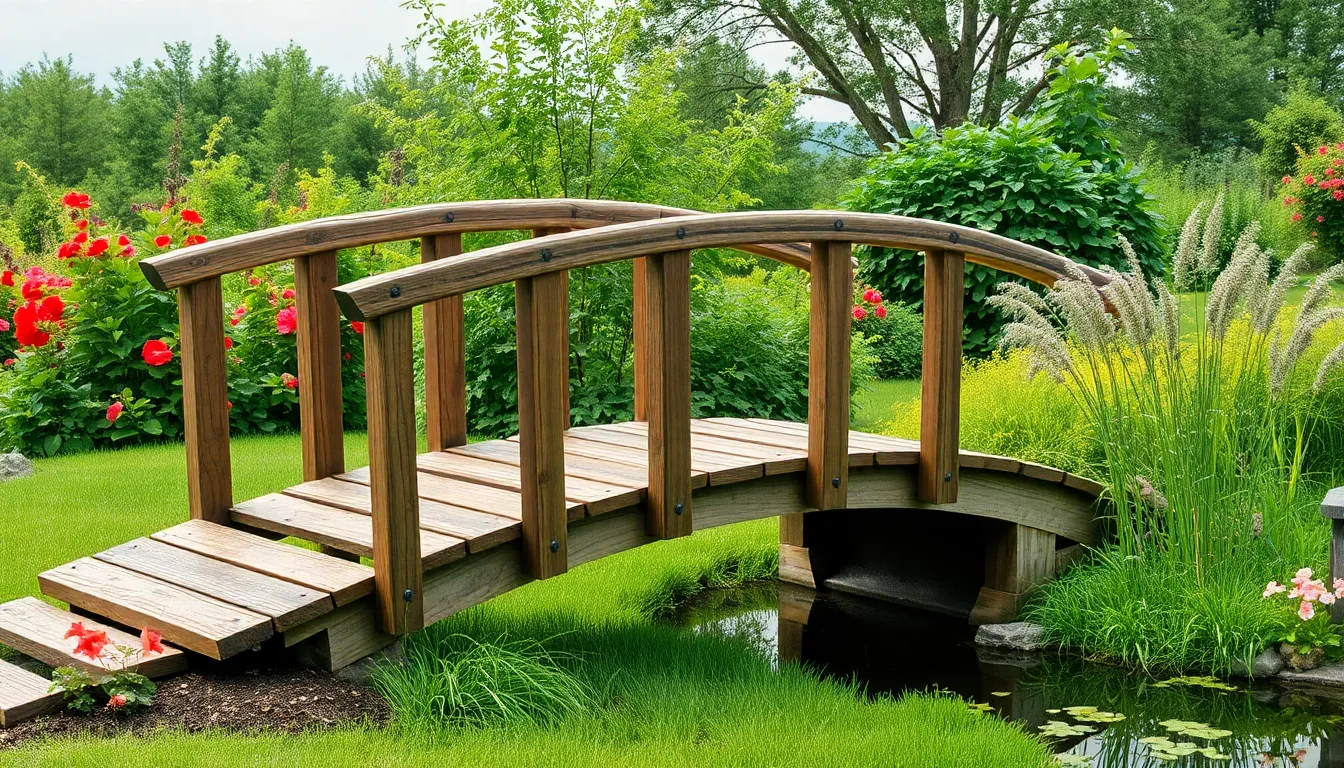
Creating a stunning garden bridge doesn’t require professional carpentry skills or an expensive budget. We’ve compiled practical DIY approaches that transform basic materials into beautiful outdoor features while keeping costs manageable.
Simple Plank Bridge Projects
Dimensional lumber forms the foundation of the most affordable garden bridge projects. We recommend using 2×6 hardwood planks for the bridge floor and 2x12s for support stringers to ensure structural integrity. Basic construction starts with measuring your span and cutting materials to size using standard tools.
Assembly becomes straightforward when you nail planks directly to the stringers in a systematic pattern. We suggest using a T-square to align rail posts perfectly and maintain consistent spacing throughout the project. Pressure treated lumber works best for outdoor applications and provides years of reliable service.
Curved designs add visual appeal without significantly increasing complexity or cost. We achieve arched shapes by using a jigsaw to cut pressure treated planks into curved sections, then adding steel pieces for additional structural support. This technique creates elegant lines that complement natural garden settings.
Safety features enhance functionality through the addition of handrails made from 4×4 posts. We recommend spacing balusters no more than 4 inches apart and securing handrails at 36 inches height for optimal safety. Paint or stain applications protect the wood while matching your garden’s existing color scheme.
Repurposed Material Bridges
Reclaimed wood materials offer eco-friendly alternatives that reduce project costs significantly. We transform old pallets into charming bridge surfaces by disassembling them carefully and rebuilding the planks into bridge decking. Fencing materials also provide excellent sources for bridge components when properly treated and reinforced.
Metal components create rustic character when incorporated thoughtfully into bridge designs. We use old metal pipes as handrail supports or decorative elements that add industrial charm to garden settings. Salvaged rails from construction sites often provide sturdy structural elements at fraction of new material costs.
Creative combinations emerge when mixing different repurposed materials strategically. We pair weathered barn wood with galvanized metal accents to create unique aesthetic appeal that reflects personal style preferences. These mixed material approaches often result in one-of-a-kind bridges that become conversation pieces.
Kit-Based Bridge Answers
Pre-made bridge kits eliminate guesswork while maintaining budget consciousness for DIY enthusiasts. Garden centers stock various kit options that include all necessary materials, hardware, and detailed assembly instructions. We find these answers particularly valuable for gardeners who prefer structured approaches to outdoor projects.
Assembly convenience makes kit-based bridges ideal for weekend projects that don’t require specialized tools. We appreciate how manufacturers design these kits with clear step-by-step processes that accommodate different skill levels. Most kits complete assembly within 4-6 hours using basic hand tools.
Quality variations exist across different kit manufacturers and price points. We recommend comparing material specifications, warranty coverage, and customer reviews before making kit selections. Higher-quality kits often include weather-resistant finishes and upgraded hardware that extend bridge lifespan significantly.
Customization options allow personalization even with standardized kit components. We enhance basic kit bridges by adding decorative elements, custom paint schemes, or industry integration features that reflect individual garden themes. These modifications transform standard kits into personalized outdoor features.
Decorative Garden Bridge Ideas with Unique Features
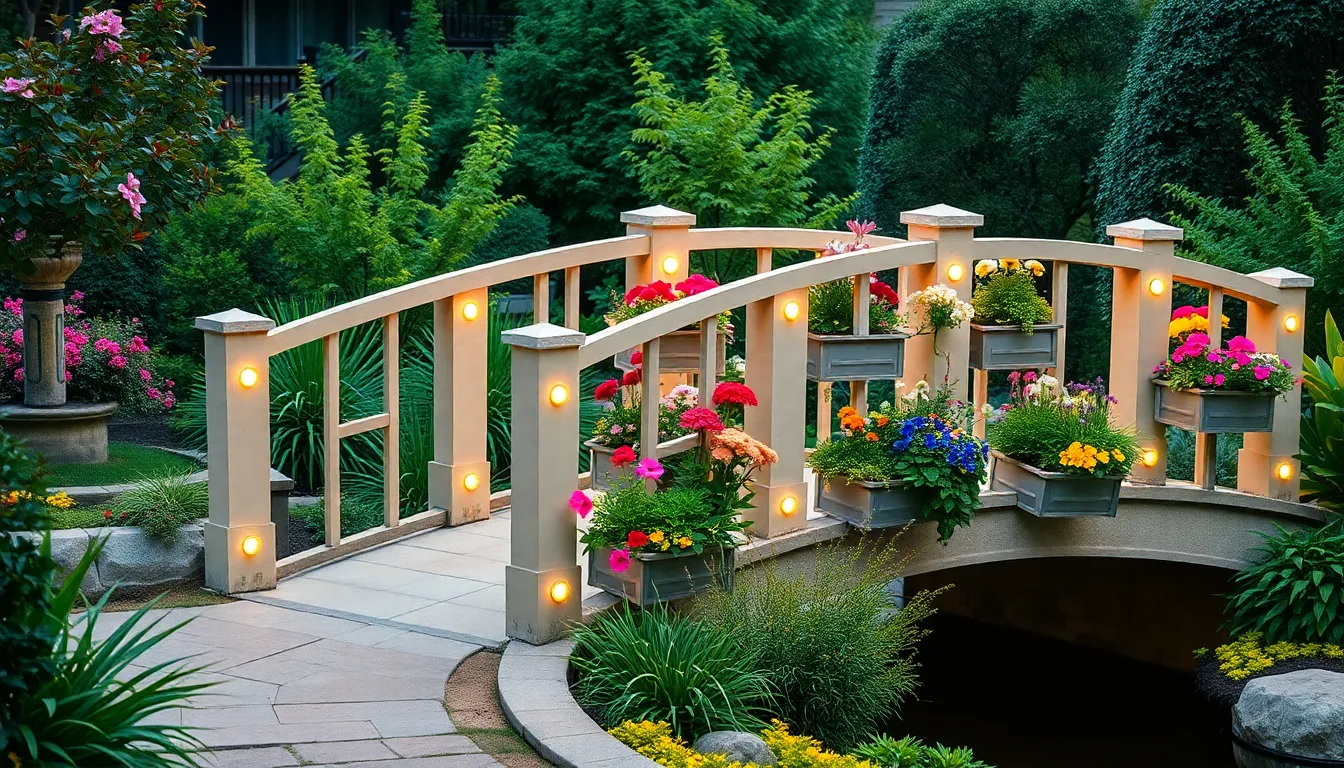
Beyond traditional bridge designs, unique decorative features can transform ordinary garden bridges into extraordinary focal points. These specialized elements add functionality and visual interest while creating memorable industry features.
Bridges with Built-In Planters
Green integration creates seamless connections between your bridge and surrounding industry through thoughtfully designed planter boxes. We recommend incorporating rectangular planters along the bridge’s edges to house seasonal flowers like petunias, marigolds, and impatiens. Built-in planters eliminate the need for separate containers while providing natural borders that define the walkway.
Floral accents transform plain bridge structures into living artworks through strategic plant placement. Consider installing cedar planter boxes at bridge entrances to showcase colorful annuals during spring and summer months. We’ve found that trailing plants like ivy or sweet potato vine create stunning cascading effects when planted in elevated planters.
Herb garden integration offers practical benefits alongside aesthetic appeal by incorporating culinary plants into bridge designs. Small herb planters filled with rosemary, thyme, and lavender release pleasant fragrances as visitors cross the bridge. These aromatic additions create sensory experiences that enhance the overall garden journey.
Illuminated Bridge Designs
LED strip lighting creates magical nighttime ambiance through energy-efficient illumination systems installed beneath handrails or along bridge edges. We suggest using warm white LED strips (3000K color temperature) to provide soft, welcoming light that doesn’t disturb nearby wildlife. Solar-powered LED options eliminate wiring requirements while reducing electricity costs.
Post cap lighting offers elegant illumination through decorative fixtures mounted on bridge posts or railings. Traditional lantern-style caps work beautifully with wooden bridges, while sleek modern designs complement metal structures. We recommend choosing fixtures with integrated timers or photocells for automatic operation.
Pathway lighting guides visitors safely across bridges through strategically placed low-voltage fixtures along the walkway. Consider installing recessed deck lights or small bollard fixtures spaced 4-6 feet apart for optimal visibility. These lighting answers create dramatic shadow patterns while ensuring safe passage during evening hours.
Bridges with Handrail Details
Wooden handrails provide rustic charm through carved details, decorative brackets, and unique baluster patterns. We suggest incorporating simple geometric cutouts or nature-inspired motifs like leaves or flowers into wooden railings. Cedar and redwood handrails develop beautiful weathered patinas over time while maintaining structural integrity.
Metal rail designs offer unlimited customization possibilities through wrought iron scrollwork, geometric patterns, or modern linear elements. Powder-coated finishes in bronze, black, or green provide long-lasting protection against weather while complementing various garden styles. We recommend working with local metalworkers to create custom designs that reflect your personal aesthetic.
Cable railing systems deliver contemporary appeal through horizontal stainless steel cables stretched between posts. These minimalist designs maintain open sightlines while providing necessary safety barriers. Cable railings work particularly well with modern metal bridges or sleek wooden structures, creating clean architectural lines that enhance contemporary garden designs.
Small Garden Bridge Ideas for Compact Spaces
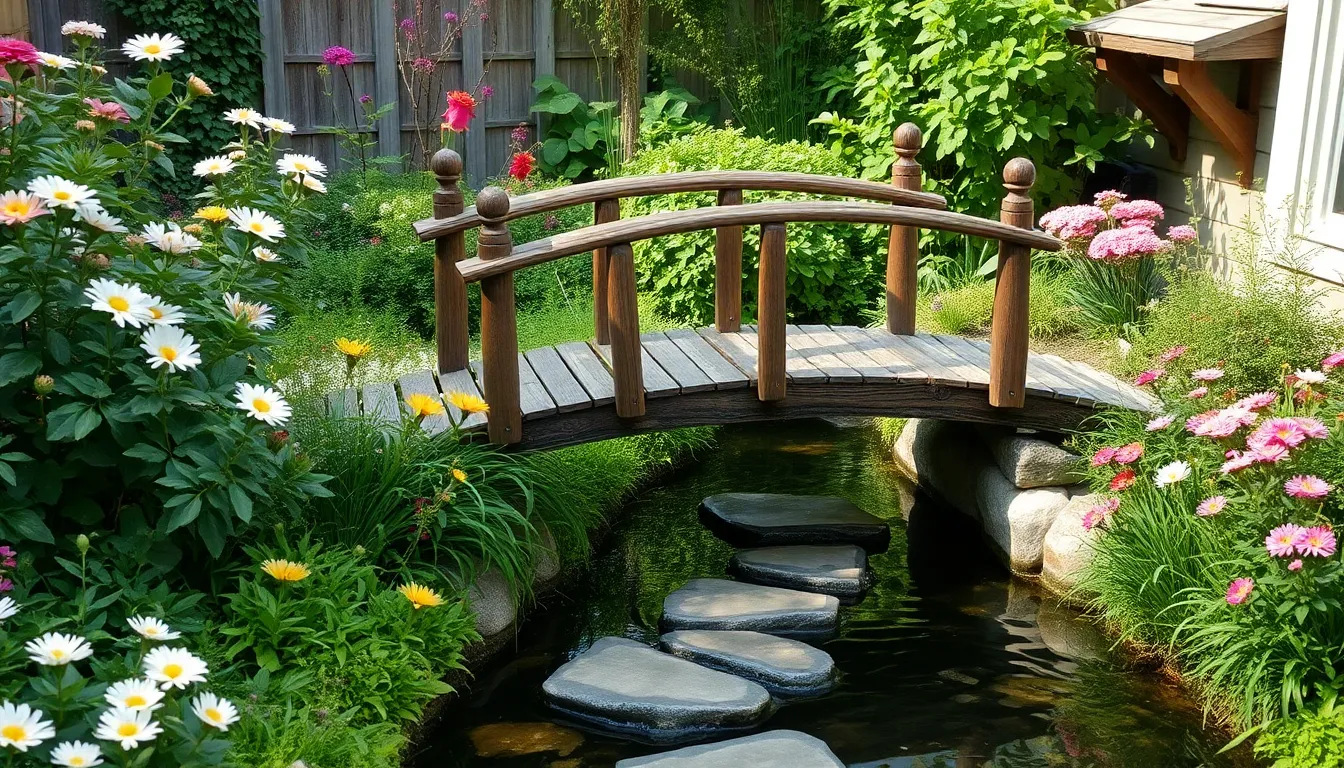
When space is limited, we can still create beautiful garden bridges that maximize visual impact without overwhelming our outdoor areas. These compact bridge answers prove that size doesn’t limit creativity or functionality.
Miniature Decorative Bridges
Handmade miniature bridges offer personalized charm for small garden spaces. Etsy features unique, artisan-crafted small garden bridges that add decorative touches to intimate outdoor settings. We’ll find these pieces bring character to even the tiniest garden corners.
DIY miniature bridge projects can be completed in a single day using common tools. Simple footbridge constructions allow us to customize dimensions based on our exact space requirements. These projects cost significantly less than pre-made options while providing complete creative control.
Compact wooden bridges from Cedar Creek Furniture showcase Northern white cedar construction that’s perfect for intimate spaces. Their durable materials resist weather damage while maintaining aesthetic appeal in smaller gardens. We can customize these bridges to match our existing garden style and outdoor needs.
Stepping Stone Bridge Alternatives
Flat stepping stones create pathways across small water features without traditional bridge structures. Large stones positioned strategically provide natural crossing points over streams or pond edges. We’ll discover these alternatives work especially well in zen gardens or naturalistic settings.
Natural stone placement mimics organic water crossings found in nature. Boulder arrangements can span narrow water features while maintaining the illusion of natural formation. These installations require less maintenance than wooden structures and develop beautiful moss patinas over time.
Concrete stepping stones offer uniform spacing and safer footing than irregular natural stones. Pre-cast options come in various sizes and textures to complement different garden themes. We can install these alternatives quickly without complex construction or specialized tools.
Narrow Pathway Bridge Options
Slender wooden bridges fit into tight spaces while providing functional crossing answers. These minimalist designs work perfectly for narrow streams or small pond connections. We’ll appreciate how cedar and redwood options resist rot while maintaining their structural integrity in confined areas.
Metal rail bridges offer modern contrast to traditional wooden garden designs. Thin metal constructions provide contemporary appeal while requiring minimal space for installation. These bridges complement industrial garden themes and modern industry architecture perfectly.
Customizable narrow bridge options allow us to specify exact dimensions for challenging spaces. Professional manufacturers can create bridges as narrow as 18 inches while maintaining safety standards. We can select materials and finishes that complement our existing outdoor features and color schemes.
Large Garden Bridge Ideas for Expansive Landscapes
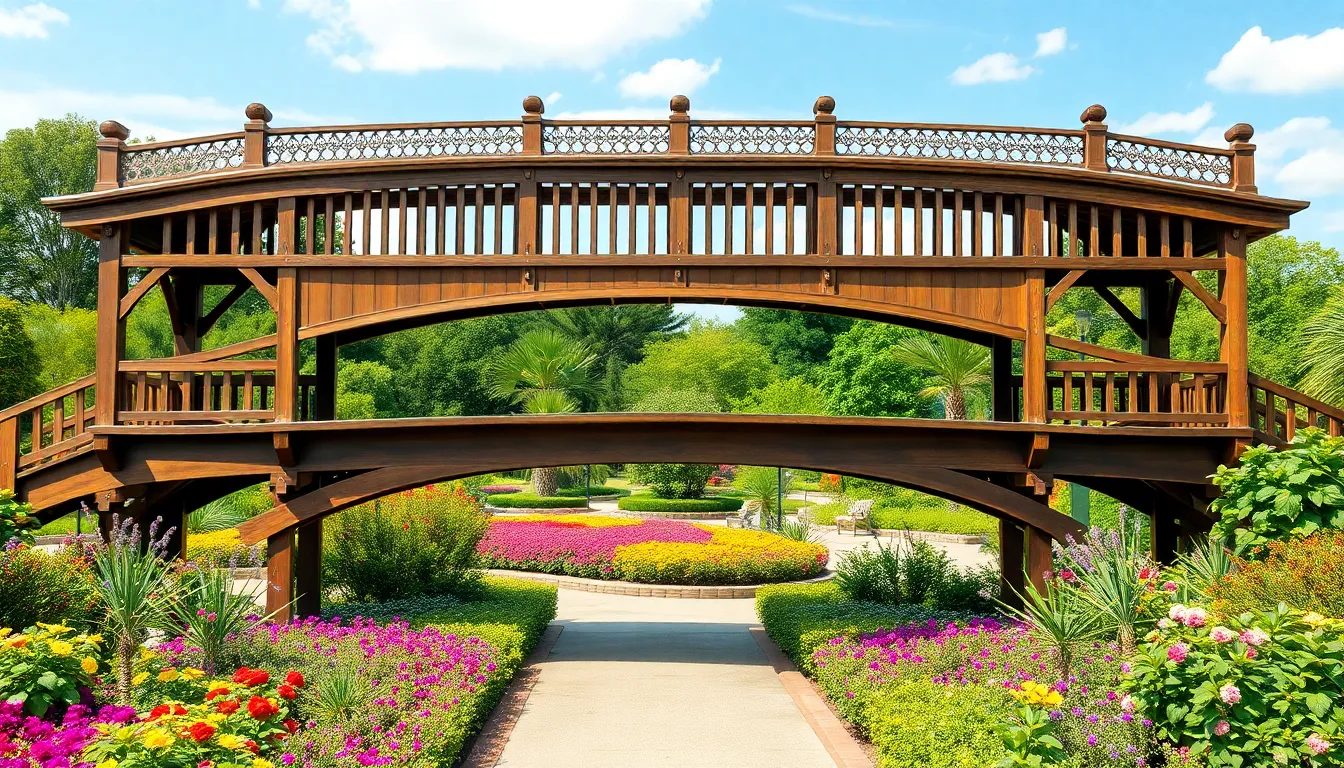
Expansive gardens deserve bridges that match their grandeur and scale. We’ll explore sophisticated designs that create impressive crossings while improving the overall industry architecture.
Multi-Span Bridge Designs
Multi-span bridges excel at crossing large bodies of water or connecting distant garden areas through multiple connected sections. These impressive structures use strategic support pillars to distribute weight evenly across extensive distances.
Arched and straight spans combine different architectural elements to create visually ever-changing pathways. We often see curved sections paired with linear segments, offering both structural integrity and artistic appeal. Construction costs typically range from $800 to $2,500 depending on materials like cedar, composite decking, or steel frameworks.
Beam and cable systems deliver modern engineering answers for wide garden crossings. Steel beams supported by tension cables create sleek profiles that don’t obstruct garden views. These contemporary designs work particularly well in formal landscapes where clean architectural lines complement structured plantings.
Wide Crossing Bridge Ideas
Wide span bridges accommodate multiple people walking side by side while creating substantial focal points in large garden settings. These generous proportions allow for enhanced decorative elements and comfortable passage.
Covered bridges protect users from weather while creating intimate spaces within expansive landscapes. Shingled roofs or pergola style tops add vertical interest and provide opportunities for climbing plants like wisteria or grape vines. We recommend cedar construction for durability, with costs ranging from $1,200 to $3,500.
Decorative railings transform functional safety features into ornamental highlights. Ornate metalwork featuring scrolling patterns or nature inspired motifs adds elegance to substantial bridge spans. Wooden balusters can incorporate carved details or geometric patterns that echo other garden structures like gazebos or arbors.
Elevated Garden Bridge Concepts
Elevated bridges offer unique perspectives of garden landscapes while creating dramatic architectural statements. These raised structures provide bird’s eye views of plantings and water features below.
Raised walkways position bridges several feet above ground level, creating impressive vantage points for viewing garden rooms and seasonal displays. Sturdy post and beam construction ensures safety while maintaining open sightlines. These elevated pathways work exceptionally well over bog gardens, rain gardens, or areas with varying terrain.
Suspended designs use tension systems to create bridges that appear to float above the industry. Cable stayed or suspension bridge principles adapted for garden use create striking modern features. Steel cables and contemporary materials like aluminum decking provide durability while maintaining sleek profiles that complement architectural landscapes.
Functional Garden Bridge Ideas Beyond Decoration

Garden bridges can serve purposes far beyond their visual appeal. We’ll explore practical applications that transform these structures into essential garden infrastructure.
Bridges Over Water Features
Ponds and streams benefit tremendously from well-placed bridge crossings. These structures provide essential pathways to access different garden areas while improving the visual appeal of your water feature. We recommend positioning bridges at the narrowest crossing points to minimize construction costs and maximize stability.
Lakes and large ponds require substantial bridge designs for safe navigation. Larger bridges create scenic walkways that improve accessibility around expansive water bodies. These crossings typically span 8 to 15 feet and accommodate multiple people simultaneously, making them perfect for entertaining guests or family gatherings.
Water feature bridges serve multiple practical functions beyond aesthetics. They eliminate the need for lengthy detours around water obstacles and provide excellent vantage points for pond maintenance tasks like cleaning or feeding fish.
Drainage Solution Bridges
Dry stream beds gain visual continuity through strategically placed small bridges. These crossings maintain the illusion of running water while providing functional pathways across decorative rock arrangements. We suggest using narrow 3 to 4 foot spans to preserve the natural flow appearance.
Rainwater runoff areas present safety challenges that bridges effectively solve. These structures ensure safe passage across potentially wet or slippery surfaces during heavy rainfall periods. Materials like textured aluminum or treated lumber with anti-slip coatings work best for these applications.
Seasonal drainage patterns often create temporary water flow areas. Bridges in these locations prevent soil erosion from foot traffic and maintain clear pathways year round, regardless of weather conditions.
Pathway Connection Bridges
Garden bed separation becomes elegant with connecting bridge elements. These structures create visually appealing transitions between distinct planting areas while preventing foot traffic damage to delicate plantings. Low profile bridges measuring 18 to 24 inches high work perfectly for this application.
Meditation spots gain enhanced tranquility through bridge connections. Small footbridges link private retreat areas to main garden pathways, creating a sense of journey and arrival that enhances the meditative experience. These intimate crossings typically measure 2 to 3 feet wide.
Multi-level garden designs rely on bridges for seamless navigation. Sloped properties and terraced gardens use bridge connections to maintain accessibility while preserving the natural industry contours.
Seasonal Garden Bridge Ideas for Year-Round Interest
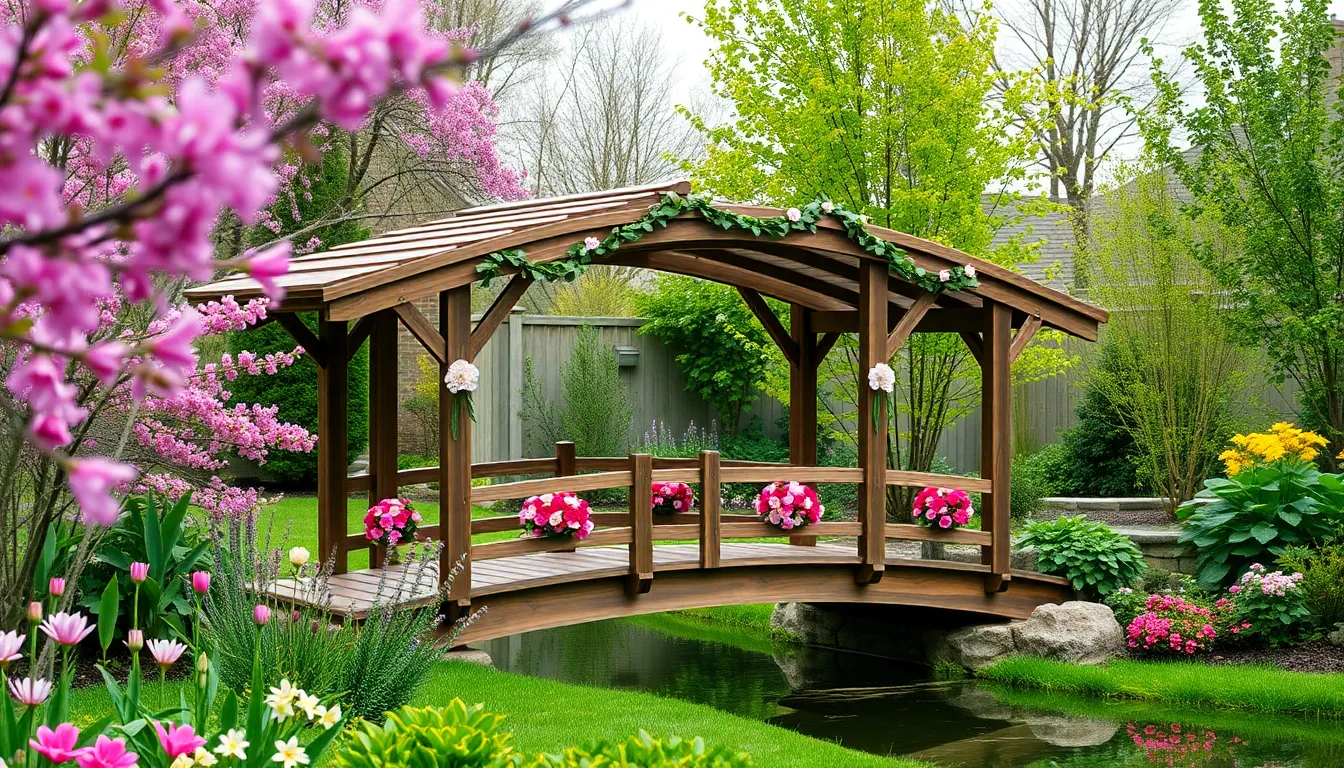
Creating a garden bridge that maintains its beauty throughout all seasons requires strategic planning and material selection. We’ll explore how to design bridges that adapt to changing weather while providing consistent visual impact year round.
Weather-Resistant Bridge Materials
Pressure treated wood stands as our top recommendation for long lasting bridge construction. This material resists rot and insect damage effectively, making it ideal for outdoor applications where moisture and pests pose constant threats. Cedar and redwood offer natural weather resistance while providing beautiful grain patterns that enhance any garden setting.
Metal construction delivers exceptional durability across all seasons. Steel bridges coated with weather resistant finishes can withstand harsh winter conditions and intense summer heat without compromising structural integrity. We recommend galvanized steel or powder coated aluminum for bridges that need minimal maintenance over decades of use.
Vinyl materials provide the ultimate low maintenance solution for busy gardeners. These synthetic options resist fading, cracking, and moisture damage while requiring only occasional cleaning with soap and water. Modern vinyl bridges come in various colors and textures that mimic natural wood grain without the associated upkeep requirements.
Seasonal Decoration Options
Spring arrangements transform bridges into vibrant focal points using blooming plants and fresh floral displays. We suggest placing container gardens filled with tulips, daffodils, and early perennials along bridge approaches to create welcoming seasonal transitions. Hanging baskets attached to bridge railings add vertical interest while showcasing colorful spring bulbs.
Summer lighting extends bridge enjoyment into evening hours through strategic illumination placement. Solar powered LED strips along handrails provide eco friendly ambiance without requiring electrical connections. String lights draped between bridge posts create magical outdoor spaces perfect for entertaining or quiet contemplation during warm summer nights.
Autumn decorations capitalize on fall’s natural beauty through seasonal plant selections and themed accessories. Mums, ornamental kale, and decorative gourds arranged in weatherproof containers bring rich colors to bridge surroundings. Corn stalks bundled at bridge entrances and artificial fall leaves woven through railings enhance the seasonal atmosphere.
Winter enhancements maintain visual interest during dormant garden months using evergreen plants and weather proof lighting. Battery operated LED lights wrapped around bridge structures provide warm illumination during short winter days. Evergreen boughs secured to railings and winter berry arrangements in frost resistant containers add natural color to snowy landscapes.
Maintenance-Free Bridge Choices
Vinyl bridge systems require virtually no ongoing maintenance while delivering consistent performance year after year. These engineered materials won’t warp, crack, or fade under extreme weather conditions, making them perfect for gardeners who prefer spending time enjoying their landscapes rather than maintaining them. Most vinyl bridges need only annual power washing to maintain their like new appearance.
Composite material bridges combine wood fibers with synthetic polymers to create surfaces that look like natural wood without requiring staining or sealing. These products resist scratching, fading, and moisture damage while providing slip resistant surfaces for safe crossing in wet conditions. Manufacturers typically offer 20 year warranties on composite bridge materials.
Aluminum construction offers lightweight durability with minimal upkeep requirements throughout its service life. These bridges resist rust, corrosion, and insect damage while maintaining structural stability in high wind conditions. Occasional cleaning with mild detergent removes dirt and debris, but aluminum bridges typically maintain their appearance for decades without refinishing or replacement.
Conclusion
We’ve explored the incredible potential that garden bridges hold for transforming your outdoor space into something truly special. Whether you’re drawn to the warmth of wooden designs or the sleek appeal of modern metal structures these features offer endless possibilities for creative expression.
Your garden bridge journey doesn’t have to be overwhelming or expensive. From simple DIY projects using repurposed materials to stunning stone installations that become permanent industry features there’s an option that fits every budget and skill level.
The beauty lies in how these structures serve multiple purposes – they’re not just decorative elements but functional pathways that connect different areas of your garden while creating focal points that draw the eye and enhance your property’s overall appeal.
Start planning your garden bridge project today and watch as this simple addition becomes the centerpiece that ties your entire outdoor space together.
Frequently Asked Questions
What materials are best for garden bridges?
The best materials depend on your budget and style preferences. Cedar and redwood offer excellent durability for wooden bridges, while steel and aluminum provide modern, low-maintenance options. For permanent installations, natural stone creates elegant, weather-resistant pathways. Composite and vinyl materials require minimal upkeep and offer long-lasting performance with excellent weather resistance.
How much does it cost to build a garden bridge?
Garden bridge costs vary significantly based on materials and size. Simple wooden bridges range from $150-$800, while metal designs cost $300-$1,200. Stone bridges can be more expensive but offer permanent solutions. DIY kits and repurposed materials can reduce costs significantly, making beautiful bridges accessible for most budgets.
Can I build a garden bridge myself?
Yes, many garden bridges are perfect DIY projects. Simple plank bridges, kit-based options, and repurposed material designs require basic tools and skills. Most projects can be completed in a weekend with proper planning. Kit bridges include all materials and instructions, making assembly straightforward for beginners.
What size bridge do I need for my garden?
Bridge size depends on your garden’s scale and intended use. Small gardens benefit from miniature bridges or narrow pathway designs. Large landscapes can accommodate multi-span bridges or wide crossings. Consider the distance you’re spanning, expected foot traffic, and proportion to surrounding landscape features.
How do I maintain my garden bridge?
Maintenance requirements vary by material. Wooden bridges need annual staining or sealing, while metal bridges may require rust prevention treatments. Stone bridges need minimal maintenance beyond occasional cleaning. Composite, vinyl, and aluminum options are virtually maintenance-free, requiring only periodic washing to maintain appearance.
What safety features should garden bridges include?
Essential safety features include sturdy handrails, proper baluster spacing (no more than 4 inches apart), and non-slip surfaces. Bridges should be engineered to support intended weight loads. LED lighting can improve nighttime safety. Regular inspections ensure structural integrity and identify any needed repairs promptly.
Can garden bridges work in small spaces?
Absolutely! Small gardens can benefit from miniature bridges, stepping stone alternatives, or narrow pathway designs. These compact solutions add charm without overwhelming limited space. Creative placement over small water features or between garden beds can create the illusion of larger spaces.
How do I choose the right bridge style?
Consider your garden’s existing aesthetic, available space, and intended function. Traditional wooden bridges suit cottage gardens, while sleek metal designs complement modern landscapes. Stone bridges work well in natural settings. Match the bridge style to your home’s architecture and existing garden features for cohesive design.
Do garden bridges need permits?
Most small decorative garden bridges don’t require permits, but regulations vary by location. Larger structures, bridges over public waterways, or those requiring electrical work may need permits. Check with local authorities before beginning construction, especially for bridges exceeding certain dimensions or spanning natural water features.
What decorative features can I add to my bridge?
Popular decorative features include built-in planters for flowers and herbs, LED lighting for nighttime ambiance, carved wooden details, ornate metal railings, and cable systems for contemporary appeal. Seasonal decorations like flowers, lights, and themed elements can transform your bridge throughout the year, creating year-round visual interest.

